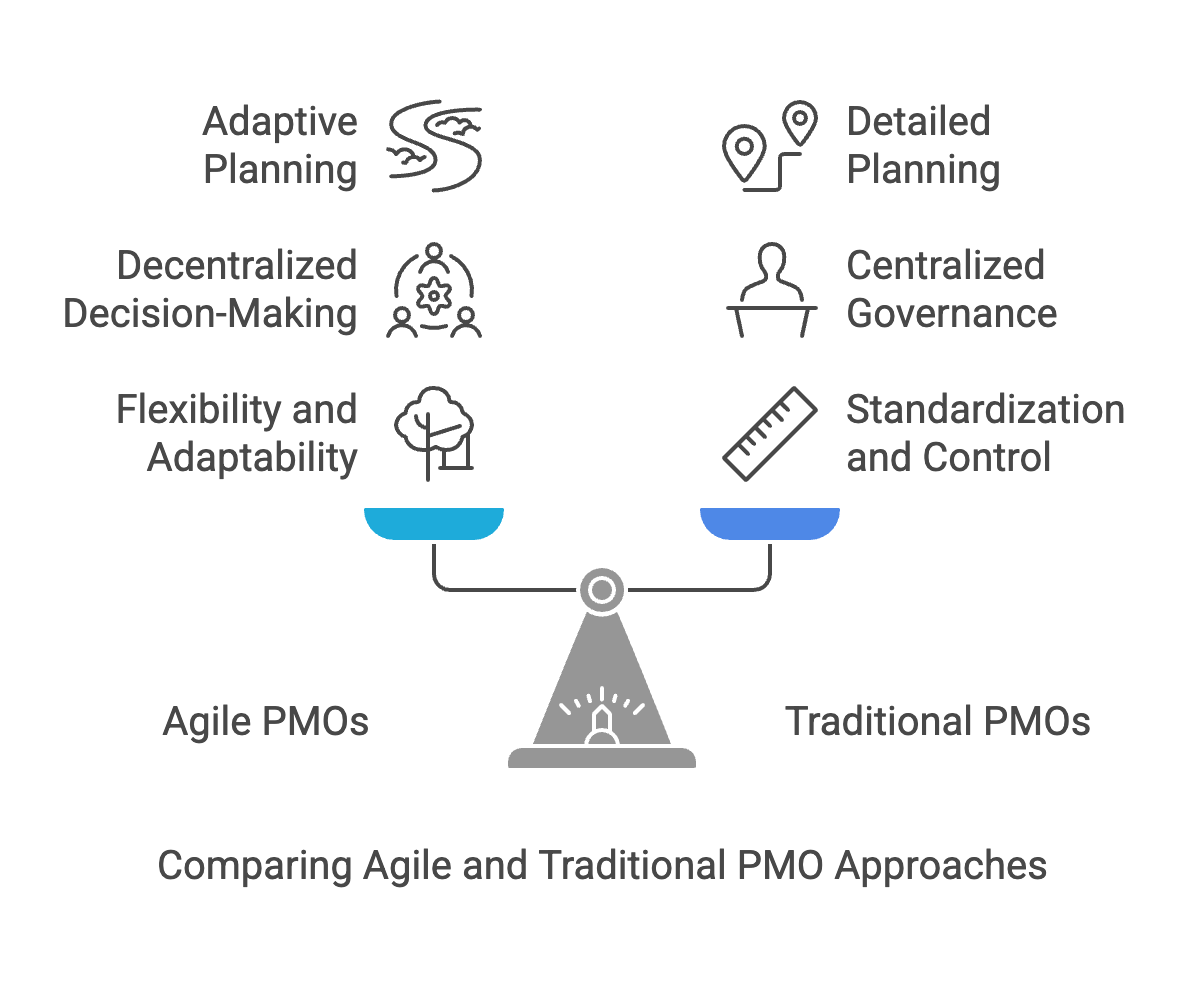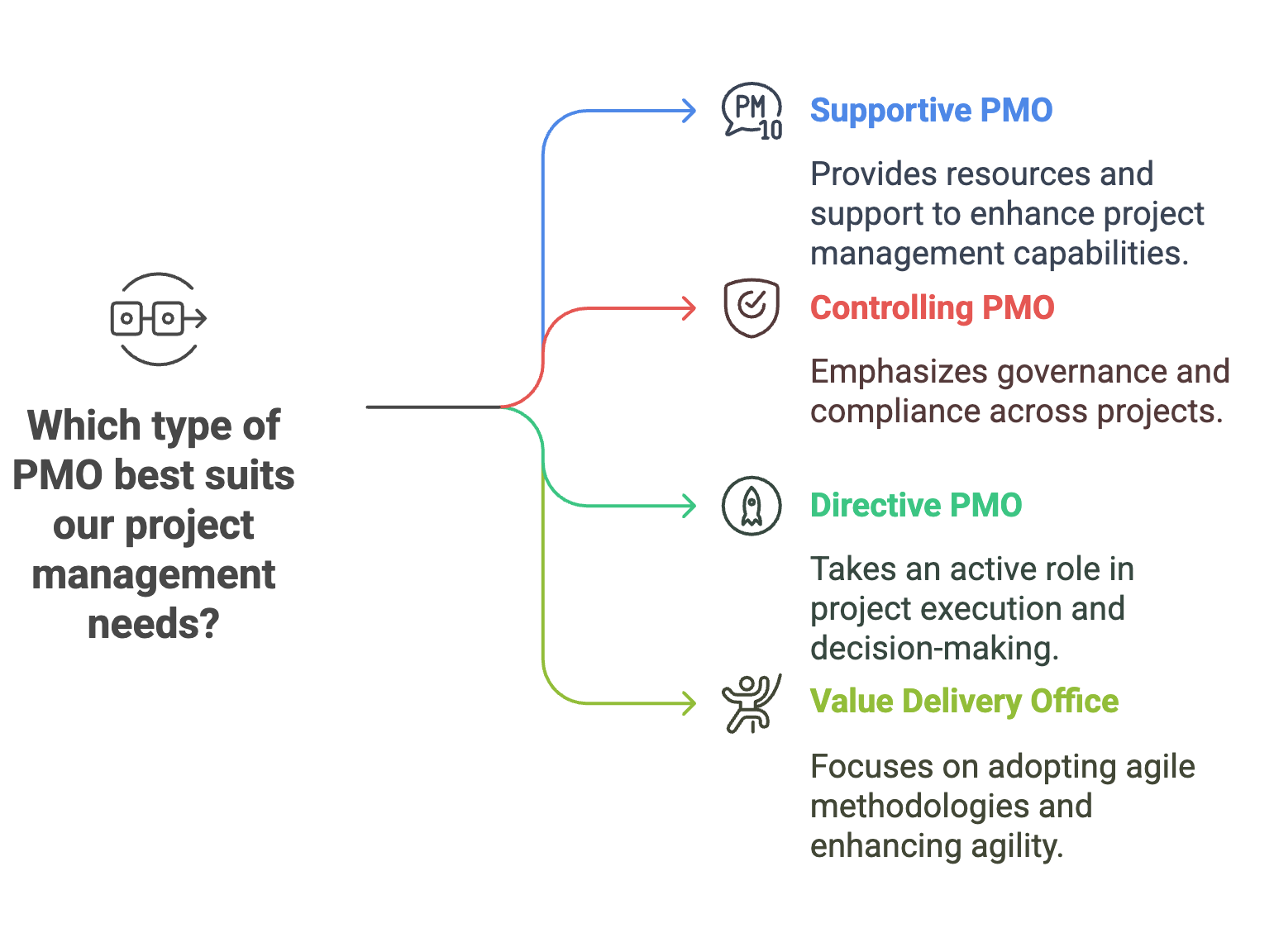The organizations often establish a Project Management Office (PMO) to centralize and standardize project-related activities. A PMO serves as a strategic driver, promoting effective project execution, governance, and overall project success. However, the nature of projects can vary significantly across different organizations, and as a result, PMOs can take on different forms and functions. This article will explore the types of PMOs commonly found in project management and highlight the key differences between PMOs in Agile and traditional organizations.
Types of PMOs
1. Supportive PMO
The supportive PMO acts as a resource hub for project management knowledge, offering templates, guidelines, and best practices to project teams. Its main objective is to support project managers by providing them with the necessary tools and resources for successful project delivery. This can include training programs, mentorship opportunities, and project management software to streamline project execution.
In addition to these services, the supportive PMO also assists in planning activities such as developing project plans, defining objectives, and setting milestones. It plays a role in risk management by identifying and assessing project risks, and it establishes metrics and tracks project performance. Furthermore, the supportive PMO fosters collaboration and coordination among project managers and teams by facilitating knowledge sharing sessions and promoting a culture of continuous improvement. These PMOs are typically found in organizations that are in the early stages of enhancing their project management capabilities, as they help establish foundational processes and practices.
Unlike controlling or directive PMOs, a supportive PMO has a more limited governance role. Its focus is primarily on providing support and assistance rather than enforcing strict control or decision-making authority over projects. Nonetheless, the supportive PMO still plays a part in reviewing project progress, ensuring adherence to project management standards, and providing recommendations for improvement. While it may not have the same level of authority as other PMOs, its role in supporting project managers and fostering collaboration is vital in driving project success within the organization.
In summary, a supportive PMO serves as a central resource for project management knowledge and support. It offers services such as templates, guidelines, and training to aid project managers and teams in their project execution. This PMO focuses on planning activities, risk management, and project performance tracking while fostering collaboration and continuous improvement. Its governance role is more limited compared to other PMOs, but it still contributes to project oversight and adherence to project management standards. Supportive PMOs are commonly found in organizations seeking to enhance their project management capabilities and establish a strong foundation for future growth.
2. Controlling PMO
A controlling PMO places a strong emphasis on governance and compliance. It establishes project management standards, processes, and policies across the organization to ensure consistency and adherence to best practices. The controlling PMO closely monitors projects, conducts audits, and provides project oversight to mitigate risks and enforce compliance. It plays a vital role in establishing project baselines, conducting quality assurance, and enforcing project management methodologies.
The controlling PMO has the responsibility to oversee the entire project portfolio within an organization. It monitors and manages multiple projects simultaneously, ensuring alignment with strategic objectives, resource optimization, and overall portfolio success. The PMO provides a holistic view of the project portfolio and ensures that projects are prioritized and managed effectively.
Typically exists in organizations with multiple departments or business units, each handling various projects. This organizational structure often leads to complex project environments with interdependencies and resource sharing. The controlling PMO helps coordinate and align projects across departments, ensuring effective communication, collaboration, and resource allocation.
In summary, a controlling PMO focuses on governance, compliance, and oversight. It establishes standards, conducts audits, and provides project oversight. It also plays a crucial role in establishing project baselines, conducting quality assurance, and overseeing the project portfolio, especially in organizations with multiple departments and projects.
3. Directive PMO
A directive PMO takes a more active role in project execution and decision-making. This type of PMO provides guidance, direction, and resources to project managers, influencing project strategies and outcomes. The directive PMO may allocate project resources, define project priorities, and actively participate in project planning and execution. It serves as a central authority for project-related decision-making, ensuring alignment with organizational goals and objectives.
The directive PMO has the authority to allocate financial resources to deliver a project. It assesses budget requirements, determines funding availability, and assigns financial resources to projects based on strategic priorities and business needs. The PMO ensures that projects have the necessary financial support to achieve their objectives.
Typically exists in organizations that have well-established project management capabilities. These organizations have a mature project management framework in place, with standardized processes, methodologies, and a culture that values project management practices. The directive PMO leverages this foundation to actively influence and drive project execution and decision-making.
4.-The Value Delivery Office (VDO) or Agile Center of Excellence (ACoE)
The Value Delivery Office (VDO) or Agile Center of Excellence (ACoE) is a specialized entity within an organization that focuses on enabling and promoting the successful adoption of agile methodologies and practices.
The VDO/ACoE primarily serves an enabling role rather than a management or oversight function. It supports teams, sponsors, and product owners in adopting and implementing agile principles and practices effectively. The emphasis is on providing coaching, guidance, and support to help individuals and teams improve their agile skills and capabilities.
Focuses on coaching teams and individuals to enhance their understanding and application of agile methodologies. It provides training, workshops, and mentorship programs to promote agile practices, such as Scrum or Kanban. The goal is to help teams and individuals embrace agility and deliver value more effectively.
Typically exists in organizations that have flatter structures and a focus on customer-centered initiatives. Flatter structures often imply decentralized decision-making, which aligns well with agile principles of self-organizing teams. Customer-centered initiatives emphasize the importance of delivering value to customers in an iterative and adaptive manner, which is a core aspect of agile methodologies.
Differences Between PMOs in Agile and Traditional Organizations
The name is not important. It can be called a PMO and still be Agile. What matters is its functions and be part of the Agile mindset.
1. Focus on Flexibility
Agile organizations embrace iterative and adaptive project management approaches, promoting flexibility and responsiveness. In Agile organizations, PMOs often adopt a more supportive and facilitative role. They emphasize collaboration, continuous improvement, and the removal of obstacles to enable agile project teams to self-organize and deliver value incrementally. Traditional PMOs, on the other hand, may have a more controlling or directive approach, focusing on compliance with standardized processes and documentation.
2. Governance and Decision-Making
In traditional organizations, PMOs typically play a significant role in governance, ensuring adherence to project management methodologies and regulatory requirements. They provide strong oversight, enforce project controls, and make key decisions based on predefined criteria. In Agile organizations, decision-making is often decentralized, with project teams empowered to make autonomous decisions. Agile PMOs focus more on providing guidance, coaching, and facilitating collaboration, allowing project teams to adapt and respond to changing project dynamics.
3. Project Planning and Execution
Traditional PMOs often emphasize detailed project planning, using techniques such as Work Breakdown Structures (WBS) and Critical Path Method (CPM). They focus on developing comprehensive project plans with clearly defined milestones, tasks, and dependencies. Agile PMOs, on the other hand, encourage adaptive planning and embrace iterative project execution. They promote the use of Agile frameworks, such as Scrum or Kanban, where project plans evolve continuously and are adjusted based on feedback and changing priorities.
4. Performance Measurement
In traditional organizations, PMOs typically employ formal metrics and performance indicators to assess project success. They utilize Key Performance Indicators (KPIs) and Earned Value Management (EVM) techniques to monitor project progress and measure outcomes. Agile PMOs, however, may adopt different performance measurement approaches. They focus on value delivery, customer satisfaction, and team productivity. Metrics such as velocity, cycle time, and customer feedback are commonly used to evaluate project performance in Agile organizations.

Conclusion
PMOs play a critical role in supporting effective project management practices and driving project success. Understanding the types of PMOs and the differences between PMOs in Agile and traditional organizations is essential for project managers and organizational leaders. The choice of PMO type and its alignment with organizational goals, culture, and project management approaches can greatly impact project outcomes. By tailoring the PMO's functions and responsibilities to the specific needs of the organization, project managers can maximize the value derived from the PMO and enhance project delivery in both Agile and traditional environments.
